May 26th, 2010
by Editor 20100526.
So what has the long trusted conservation brand of the National Parks and Wildlife Service come to represent in New South Wales?

Does tourism and revenue matter more than conservation?
The NSW Keneally Government’s Tourism Bill threatens to introduce specific tourist development provisions into the National Parks and Wildlife Act, 1974, including a long shopping list of facilities to allow for such things as fast food joints, supermarkets, golf courses, rifle ranges, conference centres and resorts of all sorts. It is tantamount to prostituting our National Parks. Instead of Parks and Wildlife being the custodian of wildlife and wilderness, it will become an ‘eco-pimp‘ – procuring visitation to protected areas that exploits and harms fragile ecology for commercial gain.

Keneally’s eco-pimp bill threatens to prevent future court appeals against bad developments in our precious National Park. Our Courts should retain the power to thrown out developments, such as private universities and wedding reception centres that don’t belong in our national parks.
Like the precursor Part 3A Planning tyranny bill before it, Keneally’s eco-pimp bill invites construction of new private accommodation facilities inside National Parks.
There is no evidence whatsoever to support the notion that private development in national parks will boost the tourism industry or provide extra funds for park management. A stronger nature tourism industry for NSW with more people enjoying the parks is best achieved by encouraging tourism investment in nearby towns where it most benefits regional communities.
There should be bi-partisan support to strengthen national park laws, not to weaken protection so as to facilitate commercial development. With our rapidly growing population, the integrity and protection of our parks is more important now than ever before.
The cost of visiting National Parks should remain small, to ensure parks can be accessible to all.
The environmental credentials of any party that supports Keneally’s Exploitation Bill, or any aspect of it, would be permanently tainted.
Keneally is blind to the motives of this anti-environment bill. Take her out of her sheltered urban environment and to experience some of our magnificent wilderness first hand may allow her to realise the precious values of the natural world and the wicked folly of this bill.
© The Habitat Advocate Public Domain
Leave a Reply
You must be logged in to post a comment.
May 25th, 2010
by Editor 20100525.
At the end of April a copy of the “National Parks and Wildlife (Sustainable Tourism) Bill, 2010” came into the possession of the Colong Foundation. This Bill introduces specific tourism provisions into the National Parks and Wildlife Act, 1974, including a long shopping list of development opportunities that would permit fast food joints, supermarkets, wedding reception centres, conference centres and resorts of all sorts.

The Colong Foundation sought the advice and assistance of Mr Tim Robertson SC, who in 2004 so admirably defended the Grose Wilderness from exclusive occupation by Fox Studios. Justice Lloyd in his judgment on that case found that the production commercial feature film “Stealth” (about rouge military aircraft), “has nothing to do” with the National Parks and Wildlife Act’s objects or the purpose for reserving land as National Park. The case was thrown out Court, but not until after several local conservationists had been arrested defending wilderness.
If this “Sus. Tourism Bill” is passed, then the legal action to stop “Stealth-type” activities will be virtually impossible and bad developments will sprout up in our precious National Parks.

The whole point of these changes is to destroy the nexus between uses of the national park and the conservation purposes for which the park was reserved, and the power of the Court to adjudicate on whether the Minister’s decision accords with those purposes. Under these new laws, it is the Minister, and not the Courts, who will decide whether a use accords with the Park’s purpose.
Mr Robertson advised that the proposed legislation “removes the legal protection of National Parks from uses which damage their ecology and landscapes, by destroying the principle that National Parks can only be used for a purpose which promotes the use of the land as a public park. It provides the legal authority for the privatisation of National Parks by enabling exclusive possession rights to be given for commercial purposes to private interests under the broad rubric of sustainable tourism. Under this rubric, National Parks will be able to be used for general tourist purposes, such as tourist resorts, convention centres, shopping centres, fast food outlets, sporting activities and fun parks, at the discretion of the Minister, even where those uses do not promote the conservation of the Parks.”
The tourist industry grab for land rights over National Parks has to be stopped. Environment groups will be taking the issue to the people at the Penrith by-election and through the media.
Given the Coalition’s stance on Part 3A planning laws, it seems unlikely that the Coalition Parties will support these new park laws. The Shadow Environment Minister, Catherine Cusack wrote to the Nature Conservation Council in November 2009 and advised that she and the then Shadow Tourism Minister, Don Page, “do not support private accommodation facilities inside National Parks.”
The NSW Government should act to strengthen national park laws as they have repeatedly promised to do, not weaken them to facilitate commercial development. National Parks and Wildlife should not be selecting development sites in parks with the aim of offering these sites to the tourism industry in an “investor-ready” form. Our parks should not become profit centres for developers.

There is no evidence whatsoever to support the notion that private development in national parks will boost the tourism industry or provide extra funds for park management. A stronger nature tourism industry for NSW with more people enjoying the parks is best achieved by encouraging tourism investment in nearby towns where it most benefits regional communities.
With our rapidly growing population, the integrity and protection of our parks is more important now than ever before.
How is it that the Coalition Parties seems capable of grasping these ideas, while the NSW Labor Government remains unresponsive?
Keith Muir, Director, Colong Foundation for Wilderness
Sydney, Australia
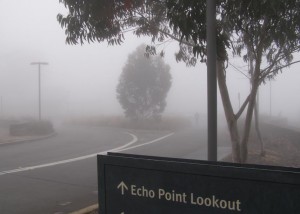
© The Habitat Advocate Public Domain
Leave a Reply
You must be logged in to post a comment.
May 21st, 2010
by Editor 20100521.
a poem….

– – –
A Scribbly Gum here I stand
My species iconic, proud, but now condemned
They cast the red die on my girth, the red mark of death
So numbingly final
Glazed thoughts I can only muster
My roots here so ancient, means nothing to them
Scribblies flourished this land since Gondwana dawn
Pervading this old stone country high and deep
– – –
Once a wild place
A natural order, virgin and vast
Of times past, these primitive escarpments hosted wilderness
When old men Scribby Gums knew no saw
– – –
Came the getters, the settlers, the saws
For conquest, for progress, for their plot with a view
Wilderness they castrate, deemed it ‘battleaxe’
Ridges and valleys to the slaughter
Slaughter they sanitized, deemed it ‘clearing’
– – –
Some saw the wrong
Some good laws got through
Some Scribblies saved from slaughter
So why not protect me now?
– – –
Heritage denied me just trees away
Relegated from their Listing, on the fringe
Zoned a resource, a fuel, a hazard
Decisions cast from the Hill, to serve those from distant hills
Now they reason I block their view, I block their way
They cast the red die on my girth, the red mark of death
– – –
I’ll miss the rain most, the best time
When nature regains control
When the cloud drifts in, when it feels wild again
And dark rumblings roam and flare above
Dousing me in soaking cloud
Wild escarpment days
– – –
Motors approach. They come for me
Only a bus, it slows, they take photos, it groans away
Quiet again
– – –
Below the cloud, a piercing sunset glows my bark gold
Down the valley, the bush blanket surges
A breeze rising up the escarpment, fans me fresh
Around me branches sway, then settle, restful
Still again,
Quiet again
– – –
Soon they come
They cast the red die on my girth, the red mark of death
My death an extinction wedge
When they scatter my woodchips on their plot
Will they know I was once a Scribbly Gum – free and wild?
Their photos will torment of treasure lost
This wild country locked in myth
Motors approach
A saw starts
No!
.
by Editor, 23-Oct-04.
© The Habitat Advocate All Rights Reserved
Leave a Reply
You must be logged in to post a comment.
May 15th, 2010
by Gorillaman 20200515.
In and upon my travels throughout our Australian continent, its shorelines and its interiors, I see the impacts of international corporatized exploitations. Some would argue that this corporate exploitive activity is a necessary component to cultivate Australia’s ongoing economy, though I myself tend to hold a far differing opinion.
This land of Australia lived quite well in our days not long past, indeed without such fervent corporates ever hunting for multi-million dollar profits so to appease the gods of corporate gluttonous predatory plunder upon our Australia.
I now question the manner in which for instance, the Howard Federal Liberal government of recent time, soon began the sell-off of such great amounts of our eternal free-flowing river waters, to whosoever chose to purchase same. Never considered by this government here, were the resultant out-takes of such huge amounts of our once proudly valued and esteemed freely-flowing and constant river waters.
There was found to be a ready market for such sales, even to be quickly sought by former government ministers with arranged corporate inclined and intended operatives, then to amass all that could be purchased and or promised, for such purposes upon open dry-lands not generally visited by the soon to be created abundancy of broad acre irrigation farming initiatives. Never considered by this government were the ensuing reductions in their effect upon our seasonal wetlands and swamp-lands, nor to the many river dependant towns and communities and so on, including the small privately owned food producing farmers downstream of such massive water out-take excesses.
The most exploited of our river systems are those that fed into and became one of the major sources of water that feeds into the Murray-Darling River Systems.
Since time immemorable these river systems above-mentioned, were ever reliant upon such as the seasonal Northern Queensland flooding rains, then of the Vic/NSW winter highland melting-snows, that seasonally would ultimately feed into the many downstream outback-area lakes, billabongs, creek systems et al, and also supplied such other particular flora and fauna dependant realms and natural water holdings. So another export commodity has arrived from the mighty corporate America that soon fails us here in our Australia.
An easily accessible internet search today, will soon reveal the huge reduction of which once were previously, the eternal annual river water volumes and flow-rates?
To compare the present situation to what we once held nationally as in important primary source of water for the Eastern States of Australia, as now now measured against the resulting huge corporate inland farming operations, has now departed us seemingly gone into the forever….
The Angry Gorillaman.
© Gorillaman All Rights Reserved
Leave a Reply
You must be logged in to post a comment.
May 12th, 2010
by Editor 20100512.
Yesterday, The NSW Department of Environment, Climate Change and Water (DECCW) within its Parks and Wildlife Group set fire to over 2500 hectares of remote wilderness in the Greater Blue Mountains World Heritage Area.
This deliberate burning was carried out in the name of ‘hazard reduction’ – in order to reduce the available ‘fuel’ (native vegetation) for potential future wildfires or bush arson.
Under the orders of the Blue Mountains regional manager, Geoff Luscombe, this deliberate burning was started around Massif Ridge some 12 kilometres south of the town of Woodford in wild inaccessible forested area of the World Heritage Area.
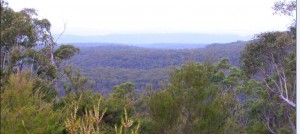
Aerial incendiary from a helicopter was used to ignite the forest vegetation floor and incinerate all ground cover and vegetation habitat across a large contiguous area, crossing over creeks and gullies. Fanned by a light southwesterly, the fire incinerated all native ground cover up to the tree canopy for a distance of 5 km into the Blue Labyrinth up to The Oaks Fire Trail.
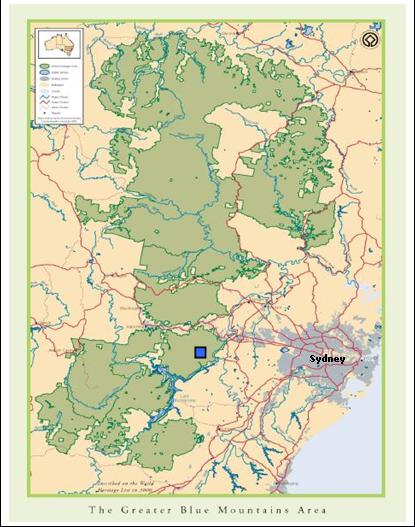
Luscombe told the media that:
“this late warm weather has created a window of opportunity for us to get this important burn done and we’re taking full advantage. “The 2507-hectare burn will be conducted south of the Woodford-Oaks fire trail, and as a result the trail will be closed to mountain bikers and bushwalkers for the duration of the burn – approximately four to five days….“This burn is aimed at reducing fuel loads to help protect properties and assets in the region.” [1]
Luscombe ignores the massive natural asset in the region is indeed the Greater Blue Mountains World Heritage Area he is setting fire to. The scale of the forested area affected equates to a 5km x 5km area, or 25km2 – an area about 1/3 the size of Lake Burragorang. Yet, the official Rural Fire Service website typically and misleadingly shows the burn area size as ‘zero’ hectares.[2]
| Incident Name |
Alert Level |
Location |
Council Area |
Status |
Type |
Size (Ha) |
Agency |
Last Updated |
| Massif Ridge Hazard Reduction |
Advice |
Massif Ridge Hazard Reduction |
Blue Mountains |
Under Control |
Other |
0 |
Dept Environment & Conservation |
|
The scale of the combined burns was also evident from the blanket of smoke smothering the entire Sydney basin and Cumberland Plain yesterday. This is shown in the following photo from the Sydney Morning Herald.
 Smoke Haze over Sydney Smoke Haze over Sydney
© Photo by Sydney Morning Herald
Broadscale Burning Policy
The purpose of bush fire-fighting is to put out bushfires and in the case of wildfires to limit their spread and impact.
However, DECCW’s bush burning policy is advocating exactly the opposite. This year up until 19th April 2010, DECCW boasts that it has performed 193 prescribed burns across NSW ‘treating’ more than 56,000 hectares. Last year it manage 168 prescribed burns ‘treating’ a similar 59,202 hectares. It claims this represents one of the biggest ever deliberate burning programs in National Parks’ history.[3] This equates to an area of national parks being burned every year approximating ¼ the area of the Australian Capital Territory; and this is on top of wildfire and bush arson.
Every year DECCW contracts helicopters and indiscriminately tosses out incendiary devices over wilderness forests. Thousands of hectares are burnt in a free-for-all and thousands of native animals are roasted. Thank crikey these State-sanctioned arsonists aren’t given access to napalm.
DECCW labels its deliberate burning of native vegetation with euphemisms like ‘hazard reduction’, ‘controlled burning’, ‘prescribed burning’, ‘cool burning’ and even ‘ecological burning’. It claims burning vast areas of vegetation somehow ‘assists’ biodiversity, justified on the simplistic premise some species of flora are fire tolerant and grow back. DECCW claims that its burning is essential to manage biodiversity to maintain the reproductive viability of a species or a community of species. DECCW’s ‘eco-logic’ is that since the bush grows back after fire it must be a good impact and therefore good for biodiversity.
DECCW terms areas of national parks targeted for such broadscale burns as ‘Strategic Fire Advantage Zones’ or SFAZs. DECCW justifies charcoaling a massive contiguous landscape as ‘assisting’ biodiversity.
Bollocks!
Luscombe himself has admitted that given the few reliable days a year it is considered safe to burn, DECCW engages in broadscale burning simply a matter of operational convenience.
Mosaic burning is too labour intensive and the typically inaccessible gullied terrain and thick forested vegetation of many national parks makes mosaic burning impracticable and too costly. Be clear; it is all about operational efficiency, not ecological biodiversity.
Last March, DECCW set fire to 2,200 hectares of native habitat in the Blue Mountains in remote wilderness in Kanangra-Boyd National Park near Jenolan Caves.[4] In April 2008, DECCW dropped aerial incendiaries in remote wilderness just to the north along the Krungle Bungle Range.
Like the Rural Fire Service, DECCW is denied serious public resources to detect and suppress wildfires, so it demonises and burns the bush, so destroying the natural asset it is charged to protect and conserve.
DECCW has descended into ecological bastardry, imposing a regime of arson fundamentalism upon nature. This is an unprincipled ‘bush-phobic’ culture.
Broadscale burning is sterilised ecosystems and driving species extinction
The Sydney Morning Herald reported ‘a rogue breeze drove smoke from hazard reduction burning in the Blue Mountains down to street level.’[5] It is more the rogue management of the National Parks Service that misguidedly thinks burning vast swathes of bush at once is good for biodiversity. This demonstrates the wanton disregard for native fauna and flora habitat and disrespect for Aboriginal cultural heritage.
Large contiguous areas of tens of thousands of hectares severely compromising flora and fauna conservation, potentially causing permanent ecological change and loss of species. In the process, DECCW is destroying natural and cultural heritage values of National Parks, causing long-term ecological damage and driving native species extinction.
Collectively, the forested area of the Blue Labyrinth now will lay sterilised of the naturally rich biodiversity of flora and fauna. When the rains come the exposed tops soil will wash away. Watercourses will choke with sediment. The thin fragile soils will change and so change the ability of the soil to replace the complex floristic structure. Only plants that are fire tolerant will recover. Only plants that are hardy to poor soils will recover. There will be less floristic diversity, not more.
Ground-dwelling mammals will have had their burrows, dens, nests, shelters burned and destroyed by the fires. Food sources for spotted-tailed quolls, rufous betongs and wombats will have gone. The undergrowth will have gone leaving a bare open charred landscape. Such a disturbed open landscape benefits feral pedators like cats and foxes and wild dogs. Complex and dense ground vegetation reduces the impacts of predators. But the post-fire regrowth takes many months and creates a simple shrub and herb layer. This allows maximum freedom of movement for cats and foxes, and provides minimum concealment for their prey.[6]
Territorial mammals and raptors do not simply relocate. They remain in their territory and have to compete with these feral predators. Many die. As top order predators like quolls and owls die, this alters the food chain and contributes to local extinctions.
Such broadscale deliberate burning of forest habitat is a threatening process driving Australia’s mammalian extinctions.
Australia has the worst record of mammalian extinctions of any country on Earth, with nearly 50% of its native mammals becoming extinct in the past 200 years.[7]
Australian native fire tolerant fauna (‘pyrophytes’) like most Eucalyptus, Acacia, Proteaceae, Xanthorrhoeaceae and many native ferns and grasses recover quickly after bush fire. However not all species of Eucalypt are fire tolerant (or ‘pyrophobes’) as commonly assumed. Eucalyptus parvula, Eucalyptus saxatilis and Eucalyptus tetrapleura are not fire tolerant. Also, some species of Acacia are not fire tolerant such as Acacia georgensis and Acacia chrysoticha.
Flora diversity varies with soils, aspect, topography and other factors. The Blue Labyrinth is characterised by a labyrinth of ridges and gullies, hence its name. Flora along riparian zones is generally wetter and not as well adapted to fire as ridgeline flora. Yet DECCW’s one-size-fits-all blanket broadscale burning of 2500 hectares up hill and own dale completely disregards the complex biodiversity variations between the gullies and ridgelines. What its blanket burning yesterday has done to the Blue Labyrinth, however, is indeed to have encouraged a consistent simpler form of regrowth vegetation – that is, less biodiversity.
Obviously no animal species is fire tolerant. The Blue Mountains provides habitat to many native mammals including Yellow-bellied Gliders, Koalas, Feathertail Gliders, Eastern Pygmy-possums, Brush-tailed Rock-wallabies, Spotted-tailed Quolls and Antechinus. What happens to these mammals when caught in burn-offs? Where are the native zoological surveys before and after reports for each of these burns?
Native mammals and raptor birds are territorial and do not relocate and typically perish. Broadscale unnatural fire regimes produce unnaturally high biomass, but not true biodiversity.
DECCW’s policy has bad biased biodiversity and fire ecology science to support its simplistic economic approach to bushfire management. DECCW has lost its way as a custodian of protected areas. It is now charged with priorities for exploitative tourism.
Land clearing and frequent broadscale bushfire continue to put many unique species of Australian wildlife at risk. Over the last two hundred years many species of plants and animals have become extinct. DECCW as trusted custodian of NSW’s natural wild areas and in increasing its frequent broadscale burning is possible the greatest contributor to species extinctions across NSW.
Broadscale Burning Justifications Lack Scientific Merit
The DECCW is charged with custodial responsibility for environmental conservation and protection of the national parks and reserves under its control. DECCW is the lead agency responsible for environmental management of the Greater Blue Mountains World Heritage Area (GBMWHA). The GBMWHA Strategic Plan provides management principles and a framework for the integrated management, protection, interpretation and monitoring of the heritage values.
Two key strategic objectives for DECCW management of the GBMWHA is to ‘identify, protect, conserve… the World Heritage values of the GBMWHA’ and to reduce the potential for major impacts to adversely affect the integrity of the GBMWHA. Where there is doubt about the potential impacts of an action on World Heritage values
the ‘precautionary principle’ shall be applied. Under the ‘precautionary principle’:
“where there are threats of serious or irreversible damage, lack of full scientific certainty shall not be used as a reason for postponing cost-effective measures to prevent environmental degradation”.[8]
Aerial incendiary to indiscriminately burn 2500 hectares of remote wilderness is clearly an impact causing serious and likely irreversible damage to important faunal habitat. Such bush fore management practice on a large congruous scale clearly lacks scientific certainty.
In a CSIRO Journal of Wildlife Research, Michael Clarke, associate professor in the Department of Zoology at La Trobe University says it is reasonable for land management agencies to try to limit the negative effects of large fires and to be sure they do not lead to irreversible damage to native wildlife and habitat.
Much hazard reduction is performed to create a false sense of security rather than to reduce fire risks, and the effect on wildlife is virtually unknown. The sooner we acknowledge this the sooner we can get on with the job of working out whether there is anything we can do to manage fires better. We need to know whether hazard reduction can be done without sending our wildlife down a path of firestick extinctions.[9]
Clarke has called for the massive burn-offs to be scrutinised much more closely.
“In this age of global warming, governments and the public need to be engaged in a more sophisticated discussion about the complexities of coping with fire in Australian landscapes.”
He wants ecological data about burns collected as routinely as rainfall data is gathered by the agricultural industry. Without it, hazard reduction burning is flying scientifically blind and poses a dangerous threat to wildlife.
“To attempt to operate without proper data on the effect of bushfires should be as unthinkable as a farmer planting a crop without reference to the rain gauge.”
In the coming decades, native plants and animals will face enough problems – most significantly from human-induced climate chaos – without having to dodge armies of public servants armed with lighters. Guesswork and winter smoke are not enough to protect our towns and assets now, and the risk of bushfires increases with the rise in carbon dioxide.[10]
The incinerating of 2500 hectares of remote bushland in the Blue Labyrinth yesterday was not to protect the houses and properties of Woodford some kilometres away.
Such broadscale deliberate lighting of thousands of congruous hectares of native forest habitat is not protecting houses. This is not clearing dead vegetation around properties. It was fuelled by an unquestioned vandalistic compulsion to burn any bushland that has not been burnt, simply for that reason and that reason alone. The bushfire management call it strategic. But it is a cultural bush-phobia – a fear and lack of respect for the natural landscape. It harks to early Australian colonial mindset that feared the bush to the extent that one had to tame it else invite wildfire Armageddon.
Contempt for Aboriginal Archaeology in the Blue Labyrinth
The Blue Labyrinth is a rugged natural region of forested hills and gullies a few kilometres south of the central Blue Mountains village of Woodford. It is an area of ancient Aboriginal culture. There are caves in the area displaying Aboriginal rock art dating back tens of thousands of years.
In February 2006, DECCW’s Aboriginal Heritage Information Management System (AHIMS) collated an official record of indigenous archaeological sites across the Greater Blue Mountains World Heritage Area. It listed some 850 discrete archaeological sites and 973 features in the GBMWHA, representative of past indigenous activities that remain in the landscape and are essentially the “Aboriginal archaeological record”.
An Assessment of the Aboriginal Cultural Heritage Values of the Greater Blue Mountains World Heritage Area by the Blue Mountains World Heritage Institute (BMWHI) in 2007 highlights the important Aboriginal cultural heritage values of the area. Recent discovery and documentation of numerous Aboriginal archaeological sites and features in the Blue Labyrinth include shelters, shelter walls, rock platforms marked with imagery and grooves. These have largely been preserved because of the rugged and inaccessible terrain. The GBMWA remains highly significant for the many Aboriginal communities associated with it and there is a renewed and re-invigorated interest in the Area’s cultural heritage.”[11]
In December 2006, leading world rock art expert Dr. Jean Clottes to dozens of sites across the GBMWHA and the central coast. Clottes was recently appointed to UNESCO to advise the institution on the creation of a World Heritage Rock Art List.

The main eagle depiction at Eagle’s Reach,
acknowledged as extremely rare by the Aboriginal community
© Photo by Paul S.C. Taçon
He was so impressed with the GBMWHA rock art sites, and associated contemporary Gundungurra, Darug, Wiradjuri and Darkinjing stories that he considers the Area to have world Heritage significance. Indeed, it was the living connections to the sites and larger landscapes that most impressed him.[12] Rock Art at Bora Cave in the Blue Labyrinth is an example of important cultural connections of the local Gundungurra and Darug to the area.
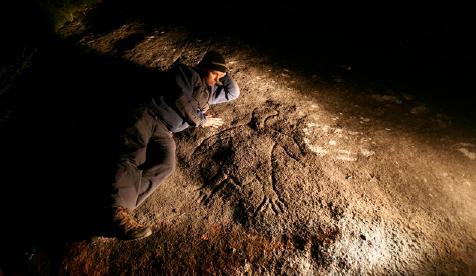
Life-size eagle engraving, Gallery Rock
© Photo by Tristram Miller
Through the Mapping Country research in the Blue Labyrinth area of the Blue Mountains National Park, hundreds of Aboriginal cultural places were recorded. The BMHWI highlighted in its 2007 report the risk of damage by natural environmental processes and exposure to modern human activities. Particularly highlighted was the risk posed by an increase in the frequency and intensity of wildfires and… and efforts to control fires can damage or destroy rock art sites. By locating and mapping sites they can be catered to as part of fire management strategies.[13]
Yet, it would appear from anecdotal evidence that DECCW failed to contact the traditional Aboriginal owners of this land to inform them of the planned burning. It is likely with such indiscriminate broadscale burning that some of the cultural sites may have been irreparable damaged.
What happened to Attic Cave, Dadder Cave and the Aboriginal archaeology between the Massif and The Blue Labyrinth? Was it burnt out and destroyed by DECCW’s needless incineration?
What happened to the wildlife and wildlife habitat? DECCW these days is more a patsy of NSW Labor right wing economic rationalism focusing on tourism revenues, than it is on its core ecological wildlife conservation raison d’etre .
References:
[1] ‘Smokin’: Sydney cloaked by burn-off’, by Paul Tatnell, Sydney Morning Herald, 11th May 2010, http://www.smh.com.au/environment/smokin-sydney-cloaked-by-burnoff-20100511-usg7.html
[2] NSW Rural Fire Service, http://www.rfs.nsw.gov.au/dsp_content.cfm?cat_id=683
[3] DECCW, Nature Conservation > Fire > Managing fire in NSW national parks > Preparation and hazard reduction, http://www.environment.nsw.gov.au/fire/prepandhazreduction.htm
[4] ‘Hazard Reduction – DECC playing with matches in Kanangra-Boyd NP’, 13th March 2009, http://candobetter.org/node/1142
[5] ‘The big smoke finally enjoys a little light relief’, by Ben Cubby, Environment Editor, Sydney Morning Herald, 12th May 2010, page 1, http://www.smh.com.au/environment/the-big-smoke-finally-enjoys-a-little-light-relief-20100511-uuum.html
[6] Chris Johnson, ‘Australia’s Mammal Extinctions: A 50,000 year history’, Cambridge University Press, Melbourne, p.226
[7] Tasmanian Department of Primary Industries, Parks, Water and Environment, http://www.dpiw.tas.gov.au/inter.nsf/WebPages/BHAN-53777B
[8] United Nations, General Assembly, ‘Report of the United Nations Conference on Environment and Development, Rio de Janeiro, 3-14 June 1992, Annex I: ‘Rio Declaration’, http://www.un.org/documents/ga/conf151/aconf15126-1annex1.htm
[9] ‘The dangers of fighting fire with fire’, by James Woodford, 8th September 2008,in Sydney Morning Herald, http://www.smh.com.au/news/opinion/the-dangers-of-fighting-fire-with-fire/2008/09/07/1220725850216.html
[10] ‘The dangers of fighting fire with fire’, by James Woodford, 8th September 2008,in Sydney Morning Herald, http://www.smh.com.au/news/opinion/the-dangers-of-fighting-fire-with-fire/2008/09/07/1220725850216.html
[11] Blue Mountains World Heritage Institute, 2007, ‘Assessment of the Aboriginal Cultural Heritage Values of the Greater Blue Mountains World Heritage Area’, p.10, http://www.bmwhi.org.au/docs/Assessment%20of%20Aboriginal%20Cultural%20Heritage%20Values.pdf
[12] Blue Mountains World Heritage Institute, 2007, ‘Assessment of the Aboriginal Cultural Heritage Values of the Greater Blue Mountains World Heritage Area’, p.10, http://www.bmwhi.org.au/docs/Assessment%20of%20Aboriginal%20Cultural%20Heritage%20Values.pdf p.26
[13] Blue Mountains World Heritage Institute, 2007, ‘Assessment of the Aboriginal Cultural Heritage Values of the Greater Blue Mountains World Heritage Area’, p.10, http://www.bmwhi.org.au/docs/Assessment%20of%20Aboriginal%20Cultural%20Heritage%20Values.pdf p.36
© The Habitat Advocate Public Domain
Tags: aboriginal archaeology, biodiversity, blue labyrinth, Blue Mountains, bush fire, Geoff Luscombe, hazard reduction, mammalian extinctions, massif ridge, prescribed burning, threatening process, Woodford-Oaks fire trail
Posted in Blue Mountains (AU), Threats from Bushfire | No Comments »
Add this post to Del.icio.us - Digg
Leave a Reply
You must be logged in to post a comment.
April 25th, 2010
by Editor 20100425.
International Wildlife Photography Exhibition 2010
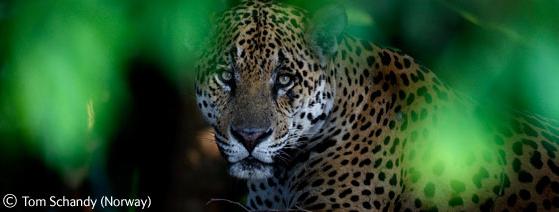 Winning Wildlife Photograph for 2010, by Tom Schandy Winning Wildlife Photograph for 2010, by Tom Schandy
Concurrently on exhibition at both the National History Museum in London and at the Australian Museum in Sydney is a brilliant display of wildlife photography, that recognises the Wildlife Photographer of the Year under a number of international awards.
On exhibition is not only the winning wildlife photographs but also those of the runners-up and the highly commended photographic entries. Entries have also been grouped into age groups so that children and young adults of differing age bracket categories also have their own competition award. This provides an excellent incentive for young people to take a special interest in wildlife and wildlife photography, for it is in our young peopke that the future of wildlife species will be utterly dependent to survive extinction.
The Editor had the opportunity to visit the exhibition held at the Australian Museum in Sydney yesterday and although this current exhibition is all but over, a visit by everyone should be an annual event. The experience is beautiful, inspiring, educational if not a touch sad when realising many of these photos may be of future extinctions. That they are in a museum is a wake up call to humanity and its morality.
Wildlife photography, the wildlife photography awards and the public exhibition of the entrants in each year’s competition contribute vitally in raising mainstream awareness of the plight of threatened wildlife, of poaching, the destruction of their habitats and the increasing risks of wildlife extinctions.
^Australian Museum, Sydney
^Natural History Museum, London
Wildlife Photographer of the Year Award 2010
Exhibited at Australian Museum, Sydney
‘Audience Type: General
Event Type: Special exhibition
Opens: 24 December 2009
Closes: 26 April 2010
Location: Level G, Special Exhibition Space
Experience the power, mystique and beauty of nature. See more than 90 dramatic images, from big cats fighting to silent icy landscapes, all in the Wildlife Photographer of the Year 2009 exhibition.
With over 43,000 competition entries from 94 countries across the globe, this is a selection of the most powerful images capturing wildlife and nature. Photography categories include:
-
- Gerald Durrell Award for Endangered Wildlife
- One Earth
- Animals in Their Environment
- Behaviour: Birds
- Behaviour: Mammals
- Behaviour: All Other animals
- The Underwater World
- Animal Portraits
- Urban and Garden Wildlife
- Creative Visions of Nature
- In Praise of Plants
- Nature in Black and White
- Wild Place
- 10 years and under
- 11-14 years
- 15-17 years.’
Exhibition Owned jointly by:

Exhibition Patron:
Exhibition Sponsor:
Major Sponsor:
Gerald Durrell Award for Endangered Wildlife
‘This award commemorates the late Gerald Durrell’s work with endangered species and his long-standing involvement with the competition. The award is given to the most memorable image and that which captures the unique character or spirit of the subject. The species featured must be officially listed in the 2008 IUCN Red List of Threatened Species as critically endangered or endangered, vulnerable or near threatened at an international or national level.’
Winner
Tom Schandy (Norway)‘The look of a jaguar’
In a small, protected area of swamp-forest in the western area of the Pantanal wetland, in Mato Grosso, Brazil, jaguars still roam free from human harassment. They’re notoriously difficult to see, and pawprints are as lucky as most people get. Along the riverbanks, though, it’s possible to spot them. When Tom took a boat down the Rio Paraguay, he saw four jaguars in three days. This male had picked a slightly concealed spot where he could watch for prey such as capybara. Tom observed him for an hour. ‘He was totally calm, even though he was aware of us.’ At sunset, the jaguar rose, yawned and scent-marked. Then he faded back into the dense forest. [Camera equipment used: Canon EOS-ID Mark III + 500mm f4 lens; 1/250 sec at f4; ISO 400; beanbag]
 This photograph is available to buy as an official print by going to the National History Museum website This photograph is available to buy as an official print by going to the National History Museum website
Runner-Up
Juan Carlos Muñoz, (Spain)
‘Elephant onlooker’

This photograph is available to buy as an official print by going to the National History Museum website
‘Not only are pygmy elephants critically endangered, but they also favour thick forest, which meant that Juan Carlos had his work cut out trying to find any. As he travelled by boat down the Kinabantangan River in Sabah, Borneo, the heavens opened. ‘It was so torrential,’ says Juan Carlos, ‘that I couldn’t decide what I was more worried about, the boat sinking as it filled up with rain or how to protect my camera gear.’ Suddenly the undergrowth parted and a male pygmy elephant looked out. Slowly munching on leaves, he serenely watched the ongoing boat chaos through the sheets of rain, giving Juan Carlos the chance to take his portrait before the elephant melted back into the forest. Pygmy elephants are found only on the island of Borneo and were classified as a subspecies of the Asian elephant in 2003. [Camera equipment used: Canon EOS-1Ds Mark II + Canon 100-400mm lens; 1/60 sec at f5; ISO 400.]
http://www.nhmshop.co.uk/veolia-environnement-wildlife-photographer-of-the-year-2009/elephant-onlooker/product.html
One Earth Award
‘This award highlights conservation issues or actions and the interaction between humans and the natural world. Images must demonstrate the power and resilience of our planet and its impact on us. Whether graphic or symbolic, each picture must be thought provoking, memorable and encourage respect or concern for our natural world.’
Winner
Thomas Haney (United States of America)
‘The lone fir’
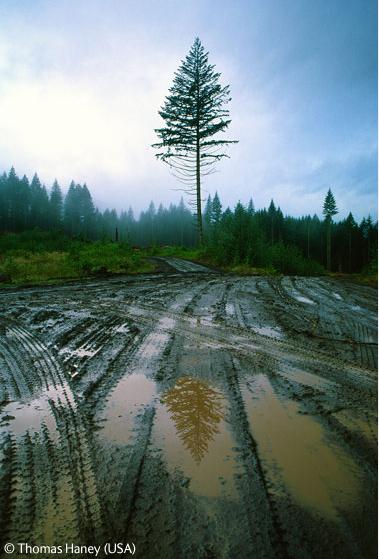 This photograph is available to buy officially as a print from visiting the National History Museum This photograph is available to buy officially as a print from visiting the National History Museum
‘It was late afternoon when Thomas came upon this scene outside Forks, Washington, while documenting old-growth logging in the Pacific Northwest. Loggers had left a single Douglas fir standing in a clearcut area, perhaps to help reseed the area for future logging. ‘As I walked towards it on the muddy road, criss-crossed with the tracks of logging trucks, I saw the reflection in the puddle,’ says Thomas. ‘It was a powerful image, reminding me of the towering forest that once stood here,’ he says. This area has been logged before, so this tree is likely to have been planted as part of a mono-age crop, vastly different from the multilayered forests that once blanketed the region. ‘Clearcutting has long been a focal point of the environmental movement, and while it seems to be falling out of favour in North America, it’s still the preferred method around the world.’
[Camera equipment used: Minolta Maxxum 7 + Minolta 20-35mm f3.5-4.5 lens, + .3 graduated-split neutral-density filter; 2 sec at f16; Fujichrome Velvia 50].
Highly Commended
Andy Rouse (United Kingdom)
Stalking the tiger

‘Andy and his guide Dicky Singh followed the fresh pug marks down the track. When they caught up with the tiger, they discovered it was Machali, a female very familiar to Dicky. Indeed, she’s something of a local celebrity in Ranthambore National Park. It wasn’t long before jeep-loads of tourists drew up to admire her. The drivers kept a respectful distance, but Machali is well used to such attention from the wildlife paparazzi. It has been suggested that Machali has contributed about $10 million to the local economy. Andy believes that ‘if we are to save this wonderful cat, then it has to have an economic value to a local community, and that’s what I wanted to show with this picture.’ [Camera equipment used: Nikon D3 + Nikon 70-200mm lens; 1/250 sec at f5.6; ISO 800.]
For more photos visit:
^Australian Museum, Sydney
^Natural History Museum, London
© The Habitat Advocate Public Domain
Leave a Reply
You must be logged in to post a comment.
April 22nd, 2010
by Editor 20100422.
About Earth Day Network
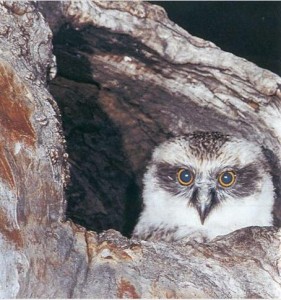 Powerful Owl chick (Brown Mountain, East Gippsland Australia) Powerful Owl chick (Brown Mountain, East Gippsland Australia)
[The following summary information has been extracted from the Earth Day website -editor]
‘Earth Day Network was founded on the premise that all people, regardless of race, gender, income, or geography, have a moral right to a healthy, sustainable environment.
Earth Day Network
1616 P Street NW, Suite 340
Washington, D.C., 20036
Tel: +1 202.518.0044 | Fax: +1 202.518.8794
http://www.earthday.org
Email general inquiries to: info@earthday.net.
Earth Day Mission
‘To broaden and diversify the environmental movement worldwide, and to mobilize it as the most effective vehicle for promoting a healthy, sustainable environment.
Reach
‘We pursue our mission through a combination of education, public policy, and activism campaigns. Earth Day Network has a global reach with more than 20,000 partners and organizations in 190 countries. More than 1 billion people participate in Earth Day activities, making it the largest secular civic event in the world.
Goals
- To Promote Civic Engagement — EDN works with partner organizations to provide opportunities for all citizens to become active at the local, state, national and global levels.
- To Broaden the Meaning of “Environment” — EDN is committed to expanding the definition of “environment” to include all issues that affect our health, our communities and our environment, such as air and water pollution, climate change, green schools and environmental curriculum, access to green jobs, renewable energy, and a new green economy.
- To Mobilise Communities — For the past four years, Earth Day Network has helped create a solid environmental platform for the National Latino Congreso. In 2010, we partnered with the Congreso to pass a strong climate change resolution.
- To Implement Groundbreaking Environmental Education Programs — Earth Day Network’s GREEN Schools Campaign seeks to green all of America’s K-12 schools within a generation. Green schools save money, conserve energy and water, and have better performing and healthier students. The National Civic Education Project is empowering students to solve local environmental problems. .
- To Help Bring Clean Water and Sanitation to the World — Earth Day Network’s Global Water Network allows individuals, organizations, or businesses to help fund water projects in rural areas around the globe.
- To Inspire and engage college students to become environmental leaders — EDN’s campus outreach seeks to grow the size, diversity, and strength of the environmental community in colleges and universities around the world.
- To Support Earth Day Events and Actions around the World — From greening schools in post-Katrina New Orleans to improving water and sanitation services in a refugee community in Ghana, EDN supports and coordinates thousands of Earth Day events worldwide each year. Earth Day, April 22, is the largest secular holiday in the world, now celebrated by more than one billion people.
Core Issues
Advocacy
Earth Day Network seeks to bridge the gap between concerned citizens and their leaders. Action is needed between individuals and organizations with local elected officials to discuss environmental issues. In this way we can push for change in Congress and the White House.
Climate Change
The Earth’s climate is significantly changing at a faster than normal rate. One thing remains clear: mankind’s actions are behind these changes. Fortunately humans are presented with the opportunity to make changes necessary to fight this phenomenon.
Promoting a campaign for reducing consumption of energy at school and at home, and reducing the use of the cars as a way of transport.
Conservation & Biodiversity
Diversity is nature’s greatest gift, but it is threatened around the world by human expansion and activities. Action is needed to help conserve the world’s biodiversity.
5th Ecosystem Services Forum
Education
Earth Day Network is a globally recognized leader in the fields of environmental education and green schools. Our Education programs carry a successful history of providing educators, students and the general public with resources and solutions to create a healthier, more sustainable planet.
Adopt a Meter2 of Land
Anacostia River Environmental Education Fair
Energy
Americans are roughly 5 percent of the world’s population and consume 25 percent of the world’s resources. Almost 50 percent of the energy we produce comes from coal. The time to build a clean energy network is now. Action must be taken to develop renewable energy and we must begin a responsible transition off of coal and oil.
Food & Agriculture
It is important that humans begin supporting organic or small farms, local production and sustainable techniques while harvesting increased yields and protecting the topsoil. The time for action is now, before the world’s rich farmland washes into the sea, and before chemical pesticides and fertilizers cause any more harm to our drinking water and our oceans.
Green Economy
We believe that the choice between the economy and green energy is a necessity to expanding the green sector and opening up a vast trove of jobs. Green industries are the future, and will put Americans back to work, producing real, exportable goods.
Green Schools
Earth Day Network’s successful history of working with teachers, PTAs, students and school administrators has led us to develop a long term, national campaign on green schools. Our National GREEN Schools Campaign, in partnership with the U.S. Green Building Council (USGBC) and The Clinton Foundation, aims to green all of America’s K-12 schools within a generation!
A school becomes “green” through a variety of means. By having more sustainable, energy-efficient, low-resource-using school buildings and school yards, our nation saves energy, reduces carbon emissions, and saves money.
By integrating environmental and sustainability education into our K-12 curriculums, our school’s students are more equipped to be leaders in the emerging green economy. We are achieving our Green Schools Campaign goals through green school policy reform, green makeovers for schools nation-wide, teacher grant programs & resources available on our Educators’ Network…
Recycling & Waste Reduction
The garbage dumps and junkyards of the world are filling quickly, with goods that might have been reused, recycled or composted. The world’s first old computers rot in scrap yards overseas, leeching toxic chemicals into the ground. Action must be taken to reduce the amount of waste we produce.
Sustainable Development
As the world’s human population grows, so does our footprint. We must find ways of living and growing in harmony with nature, and with the earth’s finite resources. Action is needed to promote green building, organic agriculture and responsible environmental practices.
Water
Earth Day Advisory Committee
Her Royal Highness Princess Lalla Hasnaa Alaoui of Morocco: President, Mohammed VI Foundation for the Protection of the Environment
Debbie Allen: American Actress, Choreographer, Television Director, Television Producer; Member of the President’s Committee on the Arts and Humanities
Ford W. Bell, DVM: President, American Association of Museums
Antonio H. Benjamin: Justice, High Court of Brazil (STJ); Co-President of the International Network for Environmental Compliance and Enforcement (INECE) and Deputy-Chair of the IUCN Commission on Environmental Law
Sir Richard Branson: British Entrepreneur; Founder and Chairman, Virgin Group
Lester Brown: Founder, Earth Policy Institute; Founder, Worldwatch Institute
Beverly J. Camhe: Producer, Beverly Camhe Productions
Richard Cizik: Evangelical Leader
Christo and Jeanne-Claude: Environmental Artists
Cerphe Colwell: Radio Legend
Phillipe Cousteau Jr.: Co-Founder, President and CEO, EarthEcho International; Ocean Environmentalist, Educator and Documentarian
Mia Couto: World-renowned Mozambican Writer and Biologist, Great Limpopo Transfrontier Park
Leonardo DiCaprio (Co-Chair): American Actor and Film Producer; Environmentalist; Founder, Leonardo DiCaprio Foundation; Board of Trustees, National Resources Defense Council; Board Member, Global Green USA
S. Richard Fedrizzi: President, CEO and Founding Chairman, United States Green Building Council
Jose Maria Figueres: Former President of Costa Rica; Sustainable Development and Technology Expert
Oliver Fleurot: CEO of Public Relations, Corporate and Financial Communications and Events Management, Publicis
Al Gore: 2007 Nobel Peace Prize Laureate; 45th Vice President of the United States
Paul Hawken: Director, Natural Capital Institute (NCI)
Denis Hayes(Chair): President and CEO, Bullitt Foundation; Coordinator of the first Earth Day in 1970
Joe Holland: United States Olympic Nordic Combined Skier and three-time National Nordic Combined Championship Winner
David L. Hunke: President and Publisher, USA Today
Benjamin T. Jealous: President and CEO, National Association for the Advancement of Colored People (NAACP)
Yolanda Kakabadse: President, Fundación Futuro Latinoamericano (FFLA)
Donna Karan: Fashion Designer and Creator, DKNY; Founder, Urban Zen Foundation
Katie Lee: Cookbook Author
Sheri Liao: President, Global Village of Beijing
Daniel Libeskind: Architect and Artist; Founder, Studio Daniel Libeskind
Maya Lin: Environmentalist, Artist, and Architect
Mindy S. Lubber: President, Ceres; Director and Investor, Network on Climate Risk
Dame Ellen MacArthur DBE: World Record Holder for solo sailing around the Earth and Dame Commander of the Order of the British Empire
Julia Marton-Lefèvre: Director General, International Union for Conservation of Nature (IUCN)
Bill McKibben: American Environmentalist and Writer; Founder, 350.org
Edward Miles: Senior Fellow, Joint Institute for the Study of Atmosphere and Oceans (JISAO); Co-Director,Center for Science in The Earth System, JISAO
Mrs. Gaylord Nelson: Wife of the late Senator Gaylord Nelson, the Founder of Earth Day
Shaquille O’Neal: Professional Basketball Player, National Basketball Association (NBA)
Raymond C. Offenheiser, Jr.: President, Oxfam America
Dr. Rajendra Kumar Pachauri: Nobel Peace Prize Laureate; Chairman, Intergovernmental Panel on Climate Change (IPCC)
John Podesta: President, Center for American Progress
Carl Pope: Executive Director, Sierra Club
David A. Randall: Recipient of the National Aeronautics and Space Administration (NASA) Medal for Exceptional Scientific Achievement and the Meisinger Award of the American Meteorological Society
Ambassador Mohamed Sahnoun: Ambassador, Special Advisor to United Nations Secretary General; Board Member, International Institute for Sustainable Development
U.S. Senator Bernard Sanders: United States Senator, from the State of Vermont
Larry Schweiger: President, National Wildlife Federation
Martin Scorsese: American Film Director, Screenwriter, Producer, and Actor, Sikelia Productions;
Founder and Chairman, World Cinema Foundation; President, Film Foundation
Pete Seeger: Environmental Activist; Performing Artist
Jigar Shah: CEO, Carbon War Room
Ben Silverman: Executive Producer, The Office; Creator, The Biggest Loser; Founder and CEO, Electus
James Gustave Speth: Professor, Vermont Law School; Dean, Yale School of Forestry and Environmental Studies; Co-Founder, Natural Resources Defense Council (NRDC)
Eric A. Spiegel: President and CEO, Siemens Corporation; Member, Business Roundtable
Achim Steiner: Executive Director, United Nations Environment Programme (UNEP)
Rabbi Warren Stone: Environmental Chair, Central Conference of Rabbis
Barbra Streisand (Co-Chair): American Singer, Composer, Film and Theatre Actress, Director, and Producer; Founder and President, The Streisand Foundation; Kennedy Center Honoree
Mark Tercek: President and CEO, The Nature Conservancy
Ted Turner: Founder and Chairman of the Board of Trustees, Turner Foundation; Founder and Chairman, United Nations Foundation; Founder, Turner Endangered Species Fund; Founder, Cable News Network (CNN)
James West: CEO, Alamy Limited
Keith Williams: President & CEO, Underwriters Laboratories Inc.
Edward O. Wilson: Harvard University Research Professor Emeritus; Two-time winner of the Pulitzer Prize; Scientist and Environmentalist
Abdelkbir Zahoud: Secretary of State, Ministry of Energy, Mines, Water and Environment of Morocco.
What are your national and local governments doing to contribute to the goals of Earth Day?
[The following summary information has been extracted from the Convention on Biological Diversity website -editor]
http://www.cbd.int/countries/profile.shtml?country=au
Note: this information is dated to 2005, so Australia is five years out of date.
In Australia:
Status and Trends of Biodiversity
Overview
‘As a large island continent Australia contains a diverse range of biogeographic regions. The arid interior occupies approximately 70% of the continent, with tropical monsoon areas to the north and a Mediterranean and temperate climate to the south. Australia’s marine habitats are just as diverse, ranging from extensive coral reefs to seagrass plains, giant kelp forests and the sand-bottomed habitats that cover much of the continental shelf. Australia is endowed with a unique and diverse biodiversity, with an estimated 80% of endemic wildlife, including flowering plants, fungi, mollusc, insects, fishes, frogs, reptiles and mammals. This high level of endemism has earned Australia its place among the world’s 12 megadiverse countries. A particularity of Australia is its marsupials, having evolved into a great diversity of species filling an extraordinary range of niches, which in other countries are largely occupied by placental mammals. As of February 2001, there were 1,478 species and 27 ecological communities listed as either endangered or vulnerable at the national level. Vegetation clearing remains a significant but diminishing threat to terrestrial biodiversity. Threats affecting Australia’s coral reefs include the effects of sediments, agricultural chemicals and nutrients, fishing and tourism, oil spills, and climate change.
Number and Extent of Protected Areas
‘Terrestrial protected areas covered 10.52% (80.89 million hectares) of the country in 2004 whereas marine protected areas, including ‘no take’ zones’, covered 64,600,000 hectares or 7% of Australia’s marine jurisdiction.
Percentage of Forest Cover
Of the estimated 33% forest cover of Australia at the time of European settlement, there is now 21% remaining.
National Biodiversity Strategy Action Plan
Major features of National Biodiversity Strategy and Action Plan
‘The overall goal of the Strategy for the Conservation of Australia’s Biological Diversity (1996) is to protect biological diversity and maintain ecological processes and systems. There are 6 main objectives, with priorities covering the identification and description of: main ecosystems, existing knowledge about biodiversity, and threats. The strategy also provides the framework to develop a mechanism and management plans for: biodiversity in general, protected areas, information and support of conservation projects, major introduced pests, control of access to genetic resources, bioregional planning and management, private lands to complement the protection provided by the public estate in protected areas, and for local governments to assume a significant role in the conservation of biodiversity.
National Biodiversity Strategy Action Plan National Strategy (English)
National Biodiversity Strategy Action Plan (English)
Implementation of the Convention
Measures Taken to Achieve the 2010 Target
‘Australia has substantially moved towards specific, time bound and measurable outcomes in regional planning under the National Action Plan on Salinity and Water Quality (NAP) and the Natural Heritage Trust (NHT). Regional plans are playing an important role in protecting and enhancing Australia’s unique biodiversity, the viability of rural and regional communities and the future of agricultural industries. Resource Condition Indicators, coordinated by the Australian Government’s Monitoring and Evaluation Working Group (MEWG), are being developed primarily to measure the performance of investments made under funding programs and to contribute to overall assessments of resource condition. The EPBC Act provides for the identification and listing of threatened species and ecological communities, the development of recovery plans for listed species and communities, the recognition of key threatening processes, and where appropriate, reducing the impact of these processes through the development and implementation of threat abatement plans. The international movement of wildlife and wildlife products for commercial purposes is also regulated under the EPBC Act and legislation to meet CITES obligations. The threat of pollution on the conservation of biodiversity is being addressed through the National Pollutant Inventory, whose goals include the maintenance and improvement of ambient air quality as well as marine, estuarine and fresh water quality.
Initiatives in Protected Areas
‘Between 2002 and 2004, terrestrial protected areas increased by 0.44% of the total land area. Designation of marine protected areas has accelerated over the reporting period with one of the most significant increases occurring because of the rezoning of the entire Great Barrier Reef, which became law in July 2004. The proportion of the Marine Park protected under ‘no-take’ zones was increased from less than 5% to more than 33%, and now protects representative examples of each of the 70 broad habitat types identified across the Great Barrier Reef region. By the end of 2002 the National Representative System of Marine Protected Areas (NRSMPA) covered approximately 64,600,000 hectares or 7% of Australia’s marine jurisdiction.
Initiatives for Article 8(j)
‘Several Australian initiatives address this article, such as the Indigenous Protected Areas Program, in which the Department of the Environment and Water Resources and indigenous communities work together to: develop management plans, and hold indigenous knowledge workshops through the Natural Heritage Trust. The Australian Government has also taken measures to engage indigenous people in the key goals of Australia’s Oceans Policy by involving them in the use, conservation and management of Australia’s marine jurisdictions. This led to the development of pilot ‘Sea Country’ Plans as a potential vehicle for indigenous involvement in marine resource use and management processes. There are currently six plans being developed, allowing indigenous people to consider their sea country management priorities, needs and interests. Finally an Indigenous Advisory Committee (IAC) has been established under the Environmental Protection and Biodiversity Conservation Act 1999 (EPBC Act). The Committee advises the Minister for the Environment and Water Resources on the operation of the Act, taking into account the significance of indigenous peoples’ knowledge of the management of land and the conservation and sustainable use of biodiversity.’
The Habitat Advocate supports the principles of the Earth Day Network.
© The Habitat Advocate Public Domain
Leave a Reply
You must be logged in to post a comment.
April 8th, 2010
This article provides an extract summary of the IUCN website – Editor.
.
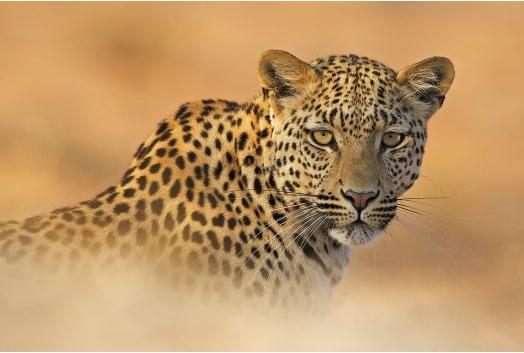 ‘Eyes in the oasis’
© Lee Slabber, (South Africa), 2009 Wildlife Photographer of the Year
.
‘Every morning, Lee would drive 50 kilometres (32 miles) across the Kalahari Desert dunes that separated two dry riverbeds in the Kgalagadi Transfrontier Park, South Africa. The only sign of life – or rather, death – was near a small pan, a mini-oasis in the middle of the dunes, where oryx bones lay scattered all about in various states of decay. One day, Lee stopped to photograph the bones. As he did so, he sensed that he wasn’t alone. ‘I got the feeling I was being watched,’ he said. ‘I slowly turned to face a most beautiful young male leopard, looking intently at me from behind a small bush. I could see how the deep-red dunes would be perfect camouflage for him.’ A moment later, the leopard fled, ‘obviously as shocked to see me as I was to see him.’
[Camera equipment used: Canon EOS-1D Mark III + Canon EF 600mm lens; 1/250 sec at f5.7; ISO 200.]This photograph is available to buy as a print.
http://australianmuseum.net.au/image/Eyes-in-the-Oasis/ ‘Eyes in the oasis’
© Lee Slabber, (South Africa), 2009 Wildlife Photographer of the Year
.
‘Every morning, Lee would drive 50 kilometres (32 miles) across the Kalahari Desert dunes that separated two dry riverbeds in the Kgalagadi Transfrontier Park, South Africa. The only sign of life – or rather, death – was near a small pan, a mini-oasis in the middle of the dunes, where oryx bones lay scattered all about in various states of decay. One day, Lee stopped to photograph the bones. As he did so, he sensed that he wasn’t alone. ‘I got the feeling I was being watched,’ he said. ‘I slowly turned to face a most beautiful young male leopard, looking intently at me from behind a small bush. I could see how the deep-red dunes would be perfect camouflage for him.’ A moment later, the leopard fled, ‘obviously as shocked to see me as I was to see him.’
[Camera equipment used: Canon EOS-1D Mark III + Canon EF 600mm lens; 1/250 sec at f5.7; ISO 200.]This photograph is available to buy as a print.
http://australianmuseum.net.au/image/Eyes-in-the-Oasis/
.
The United Nations (UN) has declared 2010 the International Year of Biodiversity.
Why?
- To seek to significantly reduce the rate of biodiversity loss by the end of 2010
- To celebrate and promote biological diversity – the variety of life on Earth
- To boost awareness of how important biodiversity is for humanity
- To highlight how seriously biodiversity and nonhuman species are threatened with extinction, and the implications for human wellbeing.
The UN’s Approach to Protecting Biodiversity
- Sound management of natural resources to support peaceful communities
- Encouraging well-balanced economic growth
- Reducing poverty
.
IUCN
The IUCN, the International Union for Conservation of Nature, is the world’s oldest and largest global environmental network – a democratic membership union with more than 1,000 government and NGO member organizations, and almost 11,000 volunteer scientists in more than 160 countries.
The IUCN helps the world find pragmatic solutions to our most pressing environment and development challenges. It supports scientific research, manages field projects all over the world and brings governments, non-government organizations, United Nations agencies, companies and local communities together to develop and implement policy, laws and best practice.
The IUCN posits 5 sound reasons why humans need to maintain health biodiversity
- To maintain food sources
- For medicinal benefits associated with diverse plant and animal life
- To mitigate the effects of climate change
- To provide employment
- To enable peoples vulnerable to the effects of climate change improve their livelihoods and increase their resilience to climate change impacts.
.
The Importance of Biodiversity for its own sake [posited by Editor]
- To respect natures processes and ecosystems
- To prevent continuing extinctions
- To prevent extreme climate change
.
To boost global awareness of the importance of biodiversity for humanity
‘The IUCN together with its Members and partners wants to see biodiversity at the top of the global agenda, leading to stronger action from all sectors of society including government and industry to safeguard it.’ ‘Humans are an integral part of biodiversity and have the power to protect or destroy it.’ ‘In the western world, we have become so far removed from biodiversity that we’ve forgotten how much we use it in our daily lives from the food we eat to the clothes we wear to the medicines we use.’
When we Bluefin tuna, we rarely think of the species that the tuna depends on to thrive, or that this species is a serious risk of being fished into extinction. When forestry agencies fell a mature tree to make a table or woodchips, mammalian habitat is lost.
.
To highlight how seriously biodiversity is threatened
Human activities continue to destroy the natural world at an unprecedented rate through habitat destruction, over-harvesting, pollution, poaching, and induced climate change. We’re facing a global species extinction crisis. We need to do better at making the scientific, social, economic and cultural case for keeping diversity, and show just how much it supports nearly every aspect of human life and progress. Through our International Year of Biodiversity focus, we’ll be doing just that, starting with a look at IUCN’s projects relating to forest biodiversity in February.
.
Risks to Biodiversity, Ecosystems and nonhumans species is at crisis point
- ‘The escalating extinction crisis shows that the diversity of nature cannot support the current pressure that humanity is placing on the planet.’
- ‘Every day biodiversity is being lost at up to 1,000 times the natural rate. The extinction of individual species, but also habitat destruction, land conversion for agriculture and development, climate change, pollution and the spread of invasive species are only some of the threats responsible for today’s crisis.’
- ‘Coral reefs provide food, storm protection, jobs, recreation and other income sources for more than 500 million people worldwide yet 70% of coral reefs are threatened or destroyed.’
- ‘17,291 species out of 47,677 assessed so far are threatened with extinction.’
- ‘Of the world’s 5,490 mammals, 79 are Extinct or Extinct in the Wild, with 188 Critically Endangered, 449 Endangered and 505 Vulnerable.’
- ‘1,895 of the planet’s 6,285 amphibians are in danger of extinction, making them the most threatened group of species known to date.’
- ‘With the current biodiversity loss, we are witnessing the greatest extinction crisis since dinosaurs disappeared from our planet 65 million years ago. Not only are these extinctions irreversible, but they also pose a serious threat to our health and wellbeing.’
- ‘From time immemorial, nature has fed us, cured us, and protected us. But today the roles have switched. We need to feed nature, we need to cure it and protect it if we want to secure a healthy and prosperous future for our children.’
- ‘Climate change is set to be one of the major drivers of species extinctions in the 21st century: approximately 20 to 30 per cent of plant and animal species are likely to be at increasingly high risk as global mean temperatures rise.’
.
IUCN Species Most Vulnerable to ‘Climate Change Extinction’
A recent IUCN report identifies the following 10 species are most vulnerable to ‘climate change extinction‘.
- ^Arctic Foxes
- ^Clownfish
- ^Koalas
- ^Emperor Penguins
- ^Leatherback Turtles
- ^Staghorn Corals
- ^Ringed Seals
- ^Quiver Trees
- ^Salmon
- ^Beluga Whales
.
Arctic Foxes

The Arctic Fox [Alopex lagopus or Vulpes lagopus]
Also known as the White Fox, Polar Fox or Snow Fox.
The total population estimate for 1997 is around 60 adults in Sweden, 11 adults in Finland and 50 in Norway.
[Source: Tannerfeldt, M. (1997). Population fluctuations and life history consequences
in the Arctic fox.. Stockholm, Sweden: Dissertation, Stockholm University].
- The Arctic Fox is one of the top land-dwelling predators of the Arctic region. It is thought to be one of the first mammals to have colonised Sweden and Finland following the last ice-age.
- As the Arctic region warms, tundra habitat may slowly be replaced by boreal forest from the South. Forest habitat is unsuitable for Arctic Foxes.
- Red Foxes prey on and are superior hunters to Arctic Foxes. Northward encroachment of Red Foxes into the Arctic Fox’s range has already been documented and is likely to continue as the tundra warms.
- Arctic Foxes prey largely on lemmings and voles. Milder and shorter winters are predicted to cause declines in the regularity of these rodents’ population cycles, as well as decreases in their overall numbers.
- These factors are likely to cause declines in Arctic Fox numbers and range size. Arctic Foxes highlight the impacts of climate change on the ways that species interact with each other, both through competition and via changes in predator-prey relationships.
.
Koalas
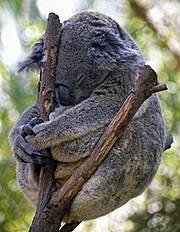
The koala (Phascolarctos cinereus)
is an arboreal herbivorous marsupial native to Australia.
According to the IUCN, as CO2 levels increase, the nutritional quality of eucalyptus leaves
is declining and the koala faces malnutrition and ultimate starvation.
[Editor: What Australian would have thought our precious and assumed plentiful Koalas could be threatened? Well the Tasmanian Tiger was once plentiful across Tasmania. None of us should take our wildlife for granted]
- ‘Koalas are iconic animals native to Australia. They are true habitat and food specialists, only ever inhabiting forests and woodlands where Eucalyptus trees are present.’
- ‘Increasing atmospheric CO2 levels will reduce the nutritional quality of Eucalyptus leaves, causing nutrient shortages in the species that forage on them. As a result, Koalas may no longer be able to meet their nutritional demands, resulting in malnutrition and starvation.’
- ‘Increasing frequency and intensity of droughts can force Koalas to descend from trees in search of water or new habitats. This makes them particularly vulnerable to wild and domestic predators, as well as to road traffic.’
- ‘Koala populations are reported to be declining due to malnutrition, the sexually-transmitted disease chlamydia, and habitat destruction.’
- ‘Koalas have very limited capability to adapt to rapid, human-induced climate change, making them very vulnerable to its negative impacts.’
.
Emperor Penguins
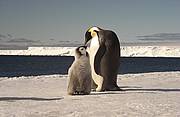
The Emperor Penguin (Aptenodytes forsteri)
The tallest and heaviest of all living penguin species and is endemic to Antarctica.
- For much of the year, Emperor Penguins live on thick sea ice in the Antarctic, which they use for mating, chick rearing and moulting.
- In some regions of the Antarctic, seasonal sea ice extent and thickness have reduced in recent decades following climate change. Continued warming will lead to further reductions in sea ice, impacting Emperor Penguins, with more northerly colonies being most at risk.
- The biomass of Antarctic krill has decreased in recent decades correlating with decreases in sea ice. Changes in krill abundance are likely to negatively affect Emperor Penguins and many other Antarctic species.
- Emperor Penguins highlight the possible impacts of rising sea temperatures and melting sea ice due to climate change. These changes directly or indirectly affect many other species in the Antarctic marine ecosystem.
.
Ringed Seals
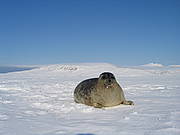
The ringed seal (Pusa hispida), also known as the jar seal
Ringed seals are slaughtered by Artic natives [Inuit] and often killed by the fishing gear of commercial trawlers.
Now climate change is a serious threat to their extence because much of their habitat is dependent upon pack ice.
- ‘Ringed Seals live primarily in the high Arctic and are heavily dependent on Arctic ice, almost never coming onto land.’
- ‘Warming spring temperatures and early ice breakup are causing nursing young to be prematurely separated from their mothers and to be exposed both to the elements and to predators.’
- ‘To cope with global warming, Ringed Seals will need to shift their territories to track suitable ice conditions. Increases in disease and disturbance by humans are also likely challenges.’
- ‘Marked decreases in Ringed Seal abundance are likely to have cascading effects in Arctic food webs. They are the most important species in the diet of Polar Bears.’
- ‘Ringed Seals highlight the direct impacts of climate change on polar habitats, including the effects ice loss has on other ice-adapted species.’
.
.
IUCN participation and Goals for 2010
.
Failure of the 2010 Biodiversity Target
Adopted in May 2002 during the sixth Conference of the Parties to the Convention on Biological Diversity, the 2010 Biodiversity Target aimed to achieve, by 2010:
‘a significant reduction of the current rate of biodiversity loss at the global, regional and national level as a contribution to poverty alleviation and to the benefit of all life on earth’.
Unfortunately, we now know that this aim is far from being met. As we are facing an ever-increasing biodiversity crisis, we need a new, clear and realistic target to respond to it.
Negotiations on the new post-2010 framework will be taking place throughout this year, paving the way for the 10th Meeting of the Parties to the Convention on Biological Diversity in October.
.
1. 2010 Convention on Biological Diversity [Japan]
To follow up on the 1992 Earth Summit in Rio de Janeiro where world leaders adopted the Convention on Biological Diversity (CBD). The Convention has three main objectives:
- To conserve biological diversity
- To use biological diversity in a sustainable way
- To share the benefits of biological diversity fairly and equitably.
The Tenth meeting of the Conference of the Parties to the Convention on Biological Diversity will take place from 18 to 29 October 2010 in Nagoya, Japan.
.
This meeting is set to be a milestone for the Convention. It is during this event that the Parties of the Convention are expected to adopt a new set of post-2010 biodiversity targets. They will also agree upon an international regime to regulate access to genetic resources and the sharing of benefits that we gain from their use.
To keep up to date visit: http://www.cbd.int/cop10/
COP10 [Nagoya] Issues for in-depth consideration
- Inland waters biodiversity
- Marine and coastal biodiversity
- Mountain biodiversity
- Protected areas
- Sustainable use of biodiversity
- Biodiversity and climate change
.
2. COP10 Meeting of the Access and Benefit Sharing Working Group [Colombia]
From 22-28 March 2010, around 600 delegates representing Parties to the Convention on Biological Diversity (CBD), non-governmental and international organizations, and partners, gathered in Cali in Colombia to give the final push to the negotiations on the international regime to regulate access to genetic resources and the distribution of the benefits derived from their use.
This is the ninth and final meeting of the Ad Hoc Open-ended Working Group on Access and Benefit Sharing (ABS) before the tenth Conference of the Parties of the Convention (COP10). The Working Group has been mandated to finalize its work and deliver an ABS international regime to be adopted at COP10 in Nagoya, Japan later this year. The clock is thus ticking but despite the pressure, delegates seem positive about a favourable outcome of the meeting.
http://www.iucn.org/cbd/?4972/Final-Meeting-of-the-ABS-Working-Group-kicks-off-in-Colombia
.
3. Million-dollar boost to people and biodiversity [West Africa]
Part of the IUCN Forest Conservation Programme this IUCN initiative works to improve the livelihoods of people in West Africa receiving a major boost in the form of a CHF 1.9 million grant from Switzerland’s State Secretariat for Economic Affairs (SECO).’
http://www.iucn.org/iyb/iucn_action_22/around_the_world/?4787/Million-dollar-boost-to-the-people-and-biodiversity-of-West-Africa
.
4. The Satoyama Initiative [Japan]
‘Led by IUCN Member the Ministry of the Environment of Japan and the United Nations University Institute of Advanced Studies, the Satoyama Initiative focuses on conserving villages and farmlands, together with the sustainable practices and traditional knowledge that they represent.’
http://www.iucn.org/iyb/iucn_action_22/around_the_world/?4699/People-and-nature
.
5. Protecting life-saving knowledge [Bangladesh]
‘In the remote area of south-east Bangladesh, known as the Chittagong Hill Tracts, IUCN Bangladesh is making sure that traditional health knowledge and practices are revived and secured for future generations.’
http://www.iucn.org/iyb/iucn_action_22/around_the_world/?4703/protecting-knowledge
.
6. Guggul Tree Conservation [India]
IUCN’s biologist Vineet Soni has enlisting the help of tribespeople of the arid regions of Gujarat and Rajasthan, in India to secure the rare ‘Guggul Tree’ [Commiphora wighii], at risk due to overharvesting. Its resin has been a key component in the ancient Indian Ayurvedic system of medicine as an effective treatment for bone fractures, arthritis, inflammation and obesity, and is now widely used in modern medicine for heart problems. Vineet has led a group of friends have founded the Indian Council for Plant Conservation to conserve threatened plant species of Rajasthan through community involvement, running workshops to help make local people aware of the importance and conservation of plants.
http://www.iucn.org/iyb/iucn_action_22/around_the_world/?4702/People-for-plants
.
7. Elephant Foster Parents [Sri Lanka]
‘In Sri Lanka, three elephants are killed every week as a result of human-elephant conflict, leaving behind defenceless orphans. To address this, IUCN State Member The Department of Wildlife Conservation has launched a novel foster parent scheme, where contributions from donors are used to shelter helpless young elephants in a transit home until they have reached an appropriate age to be released into the wild.’
http://www.iucn.org/iyb/iucn_action_22/around_the_world/?4511/Elephant-foster-parents-in-Sri-Lanka
.
8. A future for Wild Cats [Colombia]
Colombia has six native wild cat species including the jaguar, puma, and ocelot. As in many other countries, the species are threatened by habitat loss, loss of prey and killing by livestock farmers. Lack of information on their populations, their prey and ecosystems have until now prevented the design of effective conservation strategies.
But thanks to multi-stakeholder efforts, the National Conservation Programme for Felids in Colombia is now underway. This has established conservation guidelines for all species by region and aims to form an integrated nationwide initiative to establish the abundance and distribution of these species and their prey, and how to tackle conflicts between the wild cats and farmers.
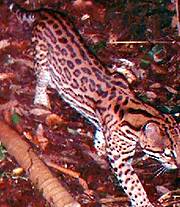
Ocelot (Leopardus pardalis)
http://www.iucn.org/iyb/iucn_action_22/success/?4512/A-future-for-Colombias-wild-cats
.
9. CoP15 to the Convention on International Trade in Endangered Species of Wild Fauna and Flora (CITES)
.
At Doha, Qatar, 25 March 2010 regulatory bodies from around the world met to discuss agreeing on conventions to ensure the continued survival of species threatened by wildlife trade.
Trade regulation for bluefin tuna, African elephants, tigers, sharks, polar bears and coral have all been under discussion in Doha.
During the conference, IUCN called for a more holistic approach to elephant conservation, urging Parties to rise above divisive issues raised at this meeting in favour of more decisive action on the known problems facing African elephants in many parts of their range including decreasing habitat as a result of the needs of growing human populations and managing human-elephant conflict.
Before the next conference in 2013 in Thailand, CITES has a huge challenge to meet in specifically addressing the key challenges and gaps identified at this conference so that discussions at CoP16 can truly support sustainable trade in all wild species.
http://www.iucn.org/iyb/resources/news/?4979/Time-for-closer-collaboration-on-wildlife-trade
.
10. Talks to dismantle trade in tiger poaching [Southern Asia]
Tigers are listed in CITES Appendix I, which includes species threatened with extinction and allows non-commercial trade only in exceptional circumstances, such as for research. Globally, on a species level, tigers are listed as Endangered on the IUCN Red List of Threatened Species™.
At COP15, poaching and illegal trade in tigers was discussed with countries being asked to provide information to the CITES Secretariat and Interpol to help develop anti-poaching strategies.
Estimates from 2007 indicated that there were as few as 3,400 tigers in the wild throughout Asia. Numbers have decreased since then. In the early 1900s there were more than 100,000. Tigers are primarily poached for their skins with other body parts being used for decorative purposes or for traditional medicines.
“If we use tiger numbers as a performance indicator then we must admit that we have failed miserably and that we are continuing to fail. How have we let this happen?” says CITES Secretary-General Willem Wijnstekers. “Although the tiger has been prized throughout history, and is a symbol of incredible importance in many cultures and religions, it is now literally on the verge of extinction.
2010 is the Chinese Year of the Tiger and the International Year of Biodiversity; this must be the year in which we reverse the trend. If we don’t, it will be to our everlasting shame.”
http://www.iucn.org/iyb/resources/news/?4923/Talks-to-dismantle-trade-in-tiger-poaching
.
11. Call for Post-2010 Strategic Plan on Biodiversity
The IUCN is calling for a clear post-2010 Strategic Plan on Biodiversity.
We have failed to meet the target adopted through the Convention on Biological Diversity to reduce the rate of biodiversity loss by 2010.
According to the Millennium Ecosystem Assessment, 60% of ecosystem services worldwide have become degraded in the past 50 years, and the IUCN Red List of Threatened Species™ gives us alarming facts on species extinction rates, which are increasing continuously.
IUCN is calling for a short, focused and action-oriented Strategic Plan to be adopted at the meeting of the Convention on Biological Diversity in Nagoya, Japan, in October.
“Simply aiming at halting biodiversity loss is no longer sufficient; we also need to restore and maintain the populations, habitats and ecological cycles that enable biodiversity and ecosystem services – such as food, water or medicine – to persist “ says Jane Smart, Director of IUCN’s Biodiversity Conservation Group. “To achieve this, we need engagement on all possible levels, with the economic sector, the development community through to the public sector and civil society. It is critical that the role of biodiversity as the foundation of life, livelihoods and development is understood by all.”
To meet these goals, perverse incentives, like subsidies that harm biodiversity, need to be removed and new regulations and financial incentives need to be put in place, clearly reflecting the value of natural resources. Greater interaction between science and policy, and cohesion between multilateral environmental agreements and other organizations are also essential for the implementation of the new biodiversity targets, according to IUCN experts.’
http://www.iucn.org/iyb/resources/news/?4962/Healthy-biodiversity-is-no-luxury—its-the-foundation-of-all-life-on-earth
.
12. Bringing the Bison Back [North America]
The next 10 to 20 years could be extremely significant for restoring wild populations of American bison to their original roaming grounds. But for this to happen, more land must be made available for herds to roam free, government policies must be updated and the public must change its attitude towards bison.
A new publication by IUCN, American Bison: Status Survey and Conservation Guidelines 2010, reports on the current status of American bison, in the wild and in conservation herds, and makes recommendations on how to ensure that the species is conserved for the future.
“Although the effort to restore bison to the plains of North America is considered to be one of the most ambitious and complex undertakings in species conservation efforts in North America, it will only succeed if legislation is introduced at a local and national level, with significant funding and a shift in attitude towards the animal,” says Dr Simon Stuart, Chair of IUCN’s Species Survival Commission.
Five hundred years ago, tens of millions of American bison roamed free on the plains of North America, from Alaska to northern Mexico. Now the American bison – which includes both plains and wood bison – is listed as Near Threatened on IUCN’s Red List of Threatened Species™. As of 2008, there were approximately 400,000 bison in commercial herds in North America, some 93 percent of the continental population. But little progress has been made in recent decades to increase the number of animals in conservation herds, which are managed carefully for their genetic diversity and ecological roles. In 2008, there were 61 plains bison conservation herds in North America containing about 20,500 animals, and 11 conservation herds of wood bison, containing nearly 11,000 animals.
“While substantial progress in saving bison from extinction was made in the 20th century, much work remains to restore conservation herds throughout their vast geographical range,” says University of Calgary Environmental Design Professor and co-editor of the study, Dr Cormack Gates, who is also co-Chair of the IUCN Bison Specialist Group. “The key is recognition that the bison is a wildlife species and to be conserved as wildlife, it needs land and supportive government policies.”
The survival of bison populations is affected by many factors, including limited habitat and severe winters. Yet the greatest challenge is to overcome the common perception that the bison, which has had a profound influence on the human history of North America, socially, culturally and ecologically, no longer belongs on the landscape.
“The decimation of the American bison in the late 1800s inspired the first recovery of bison and an entire conservation movement that protected wildlife and wild places across North America,” says Keith Aune, Senior Conservation Scientist, Wildlife Conservation Society. “The IUCN Status Survey and Conservation Guidelines provide a new framework for inspiring a second recovery of bison and restoring functional grassland ecosystems.”
Bison have the best chance of full recovery as wildlife by being allowed to roam freely across hundreds of thousands or even millions of hectares. Making this possible poses one of the biggest challenges for restoring bison herds as both public and private landowners will need to give their support.
“The bison is the largest land mammal in North America, and yet it is perhaps the most neglected icon,” says Steve Forrest, WWF Northern Great Plains Manager for Conservation Science. “These guidelines provide a roadmap for bringing the bison back to its rightful place as a keystone of the great plains.
http://www.iucn.org/iyb/resources/news/?4750/Bringing-Bison-Back-to-North-America
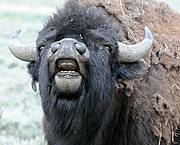
Bison on the American Prairie Reserve
Photo: Steve Zack, Wildlife Conservation Society
.
Further Reading
.
http://www.iucn.org/iyb/
http://www.iucn.org/iyb/resources/news/
http://www.cbd.int/2010/welcome/
http://www.countdown2010.net/year-biodiversity
http://www.unep.org/iyb/
http://www.environment.gov.au/biodiversity/
http://www.environment.gov.au/biodiversity/strategy/draft-strategy.html
http://www.healthyparkshealthypeoplecongress.org/
.
Leave a Reply
You must be logged in to post a comment.
|
|





































